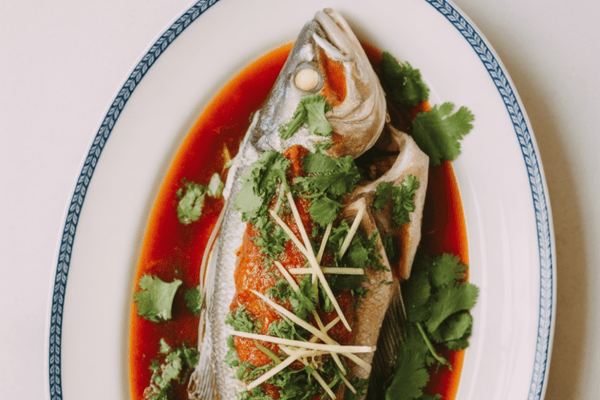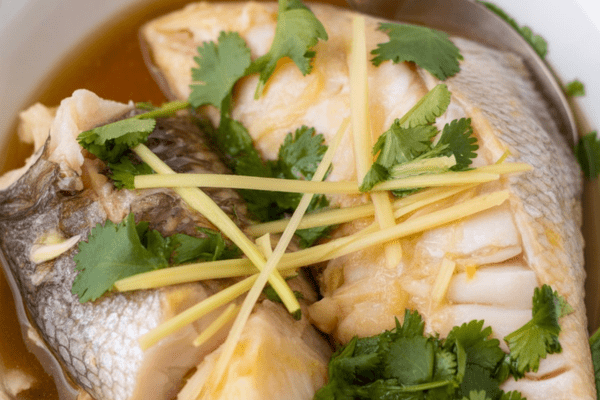There’s something truly special about placing a beautifully steamed whole fish on the table. Growing up, I remember this dish being the highlight of any big meal—it meant family was gathered, someone had gone to the fish market early, and the rice cooker was working overtime.

This Chinese-style steamed fish with ginger, scallions, soy, and fresh herbs is a classic you’ll see at Chinese New Year, weddings, and Sunday dinners alike. It feels celebratory, but it’s actually very doable at home. I love making this when I want to show my family I put in a bit of extra love—even if the real work is pretty simple once you get the hang of steaming.
If you’re used to steaming fillets, you’ll love the way a whole fish turns out: moist, tender, and infused with aromatics from head to tail. And yes, I’m going to walk you through every step—including how to serve it so it looks beautiful on the table.
Choosing Your Fish: My Go-To Picks
I always tell folks at the market to get what’s fresh. You don’t need anything fancy—just a nice whole fish around 1 to 2 pounds.
Personally, I love striped bass. It’s delicate but firm enough to steam well. Sea bass is another good option, though I find it a bit meatier. Flounder, fluke, or grey sole are all lovely too.
If you’re lucky enough to live near a good fish market (ours has live tanks!), you’ll get something truly fresh. But don’t stress if you can’t—it’s still very good with fresh (even if not live) fish.
One thing I always mention: buy what’s in season. It tends to be cheaper and tastes better. Sometimes I’ll ask the fishmonger for advice—those folks know what’s coming in fresh.
If you can’t get a whole fish, you can absolutely steam fillets using the same flavors. I’ve done that plenty of times on busy nights.

Prepping the Fish: Don’t Skip These Steps
Here’s where a little care makes a big difference. Even if your fishmonger does some prep, I always check these things at home.
I’ve had a few dinners where I forgot to remove all the scales and had to pick them out at the table—not exactly elegant!
Here’s how I do it:
- I run a serrated knife along the belly and top edges to catch stray scales, especially near the fins and head.
- Using kitchen shears, I trim off the tough fins, leaving the head and tail for that classic look.
- I always check the cavity. If there’s a membrane hiding a blood line, I scrape it clean with a spoon. This helps avoid any strong, fishy taste.
- I peek at the gills. Even if the fishmonger says they’re gone, sometimes they miss a few. Older guests who love the head will thank you for this step.
- A good rinse under cold water is all you need. No salt or wine at this stage. Trust me: the seasoning comes later.
Setting Up Your Steamer: My Home Hack
Now let’s talk steaming.
In a restaurant kitchen, they might have huge steamers, but at home? I use my old wok with a steam rack. It’s saved me countless times.
If your plate is long (some fish need the space), you can improvise by setting the rack on an empty metal can with both ends removed. It keeps the plate above the water perfectly.
This makes me think of all the times my mom and I rigged up these DIY steamers together. It’s part of the fun—figuring it out and feeling like you made something special.
Steaming the Fish: The Main Event
Place your cleaned fish on a heatproof plate that fits in your steamer setup.
Steam over high heat for about 9 minutes. Don’t wander too far—it cooks fast.
A trick I always use: slip a butter knife into the thickest part. If the meat is opaque to the bone but the bone itself still has a little translucency, you’re good. Remember, you won’t eat the bone—it’s fine if it’s not totally cooked through.
After steaming, you’ll see liquid collected on the plate. Carefully pour that off so your sauce later doesn’t get diluted.
Building the Flavor: My Sauce Routine
Here’s where this dish truly shines.
I spread half the ginger, the green parts of the scallions, and the cilantro over the steamed fish right away. The heat helps the flavors bloom.
Meanwhile, in a small bowl, I mix water, salt, sugar, light soy sauce (or seasoned soy), and a touch of white pepper.
In a small pan, I heat oil with the remaining ginger until it sizzles, then add it to the sauce mixture. I let it come to a gentle simmer so everything melds.
Then I add the white parts of the scallions and the rest of the oil. Once it sizzles again, I know it’s ready.
I pour this glorious sauce all over the fish. The sizzle, the smell—this part always gets the family wandering into the kitchen asking when dinner will be ready.
My Tips for Serving It at the Table
Presentation matters with this dish. I like bringing it to the table whole so everyone can see how beautiful it is.
But once the oohs and aahs are done, I’ll help guests avoid bones by serving it neatly.
Here’s how I do it:
- Using a butter knife and serving fork, I separate the top fillet from the backbone.
- I carefully lift the meat and set it aside.
- I then remove the backbone starting from the tail. It usually comes out in one piece if you’re gentle.
- I set aside any extra bones along the ribs.
If we have guests who love the fish head, I leave it on the plate. Personally, I always sneak the cheek meat for myself—it’s the softest, most flavorful bite.
Finally, I spoon more of the sauce over the deboned fish and invite everyone to dig in.

Rice on the Side: Don’t Skip It
You can’t serve this dish without rice.
That sauce, soaked into hot rice, is the best part for me. When my kids were younger, they’d skip the fish entirely and just ask for rice with “fish sauce” from the plate.
So make sure you have plenty ready. Leftovers reheat well too—though you might not have any!
A Few Parting Thoughts
This dish isn’t just a recipe for me. It’s family. It’s memories of my dad bringing home the freshest fish he could find, of my mom patiently scaling and cleaning it, of loud, happy dinners with everyone talking over each other.
Cooking it at home keeps that feeling alive.
If you’ve never tried steaming a whole fish before, give it a go. It’s simpler than it seems and worth every bit of effort.
Don’t forget to enjoy the best parts—the cheeks, the tender belly, and most of all, the smiles around the table.
Chinese Steamed Fish

Delicately steamed and finished with fragrant ginger, scallion, and soy sauce, this traditional Cantonese-style whole fish is a centerpiece dish that brings elegance and flavor to the table.
Ingredients
- 1 whole striped bass or sea bass (about 1½ lbs/680g, cleaned)
- ¼ cup water
- ¾ teaspoon sugar
- ¼ teaspoon salt
- 8 sprigs fresh cilantro, roughly chopped
- ¼ cup canola oil, plus 2 additional tablespoons
- ¼ cup light soy sauce (or seasoned soy sauce)
- Fresh ground white pepper, to taste
- 3 tablespoons fresh ginger, finely julienned
- 2 scallions, finely julienned (keep green and white parts separate)
Instructions
- Start by checking the fish for any remaining scales, especially near the belly and along the fins. Use a serrated steak knife to gently remove them. Trim the tough side and top fins with kitchen shears, but leave the head and tail intact—this adds visual appeal when serving.
- Inspect the inside of the fish; you should see the backbone and possibly a thin membrane. Carefully cut into that membrane and clean out any bloodline along the bone with a spoon or your fingers. Check the head and remove any remaining gills.
- Rinse the fish thoroughly, shake off excess water, and place it on a heat-proof plate. Avoid seasoning the fish before steaming—no salt, oil, or wine.
- To steam the fish, place your heat-proof plate on a metal rack inside a wok or large pot. Ensure the plate sits above the water level—if needed, elevate the rack using an empty can (both ends removed) as a stand.
- Cover and steam the fish for about 9 minutes over high heat. To check for doneness, gently lift the flesh with a butter knife—it should be opaque to the bone. Once cooked, carefully pour off the excess liquid collected on the plate.
- Top the fish with half of the ginger, the chopped cilantro, and the green parts of the scallion.
- In a small bowl, whisk together water, salt, sugar, soy sauce, and white pepper. In a small saucepan, heat 2 tablespoons of oil with the remaining ginger until it sizzles. Pour in the sauce mixture and bring to a gentle simmer.
- Add the remaining ¼ cup oil and the white parts of the scallion. Once the mixture is hot and sizzling again, immediately spoon it evenly over the fish.
- Serve the fish hot, straight from the plate, with steamed rice and stir-fried greens on the side for a complete meal.
Nutrition Information
Yield
4Serving Size
1Amount Per Serving Calories 205Total Fat 15gSaturated Fat 1gTrans Fat 0gUnsaturated Fat 13gCholesterol 27mgSodium 1271mgCarbohydrates 4gFiber 1gSugar 1gProtein 14g
Easy Shrimp Recipes.com, occasionally offers nutritional information for recipes contained on this site. This information is provided as a courtesy and is an estimate only. This information comes from online calculators. Although allchickenrecipes.com attempts to provide accurate nutritional information, these figures are only estimates.

